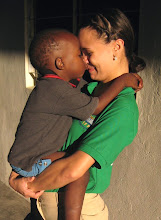Mozambique, is, for many days of the year, hot. Hot is where people say “37 today” as they open their windows for a breeze and refuse to touch you when they great you because they are sweating. Hot is rolling out of bed and onto the floor to sleep because the tile is a cooler than a mattress. Hot is sweat droplets appearing above your lips as you sit quietly in church and salt stains appearing on your clothing. Hot is taking a shower immediately after waking up after having soaked the sheets in the night and noticing that your hair is always wet, even on days when you don’t wash it. Hot is garlic growing white mold and pineapples quickly fermenting despite their hard skin. In the summer, every day is what people in the States would call 90, 100, or 105. But if it’s not 105, it’s hardly worth the trouble to say it’s hot, since it’s just another day.
Mozambique is, in many places, dirty. Dirty because dirt is the natural state of the earth and if you want something other than dirt, you have to pave. Paving costs money and who has many to pave? Except for the national highway, the major roads in the capital city, and the corridors of our Japanese designed school, almost everywhere I walk is through dirt. The dirt is deeper when tractors go through it, stickier during mango season, worse after it rains. Drainage systems don’t always exist, so sometimes dirty water sits on the road until a car passes and launches the water into the air.
Mozambique is, in many aspects, poor. The limited economy provides very few jobs in even fewer sectors, so except the lucky few who have foreign roots, capital, or education, most people don’t have money to buy things. When people don’t have money to buy things, the low demand results in high prices. New clothes can only be afforded at the cost of good food.
All of these factors seem to point to one conclusion: Africa is not the place for fashion. Even if you can afford it, it is too hot to wear it, and even if you wear it, it will quickly become dirty in a place where it cannot be dry cleaned. Peace Corps Volunteers, therefore, arrive in the country with shaved heads, water proof pants, and one all-purpose pair of quality sandals. The leave behind nonsense like perfume and jewelry, dress shoes and button-down shirts.
Mozambicans, however, see it differently. The woman augment their hair with heavy extensions despite the heat. They would not wear flats if they had heels, would not wear plain things if they had colorful things, would not go without jewelry if you could perhaps match your green blouse with green earrings. The men only wear well-ironed dress pants and meticulously scrubbed cleaned shoes.
It took me a great many months to fully adopt what I saw as a sign of self-esteem. Looking nice is not a result of an environment, it is a result of an attitude, a personal standard. It is always something you can control to some extent. I have never been the type of volunteer to consider going to Africa a chance to climb Kilaminjaro, so from the beginning, I left behind the mountaineer’s gear (or rather never had) in favor of two pairs of high heel shoes. When told to pack “business casual,” I never envisioned this as pants that did not reach the ankles with shoes that can double to exercise in. It took me a while, however, to actually wear the heels enough to buy a third pair. (White, when my black or brown wouldn’t do.)
Eventually I added daily eyeliner to the mix, decided I could arrange my own eyebrows with a good pair of teasers, but stopped cutting my own hair, which was never good news. I still didn’t feel I have money to go to a white person salon in the capital, however, which are designed for wealthy ex-pats, so I trusted my head once to an outdoor barber beneath a tin roof at the bus terminal. I had confidence in him since he could actually see what he was doing. The huge man was so nervous, however, that he cut off almost nothing with the gigantic shears that are probably meant for flowers and not hair.
I hunted through used clothes piles for pencil skirts and bargained on the street over the price of belts. Seventy Metecais ($2.30) was so expensive! How about 60? ($2.00). I gave in, at least partially, to the idea of monochromatic. I would wear a purple skirt with a purple t-shirt but stop at adding purple earrings or purple shoes. Or I put on purple earrings along with a purple tank-top, but that was the end of the purple. I was sold nearly completely on culture of color, however, and began to fill my closet with $1 finds in blight blues, all shades of green, and splashes of orange. I began to wonder how a perfectly happy person could wear all black, and even hesitated to buy one black shirt even though it fit perfectly. I realized most of my pants were too loose so I took them to the tailor.
Dressing in the morning became fun. I began to find approval in the all-seeing and all-saying eyes of Mozambicans. They liked my eyebrows. They asked for my makeup. They thought I was" chic." They still thought my jeans needed a belt. And so I did what Mozambicans do, which is to combat the circumstances and end out on top.

No comments:
Post a Comment